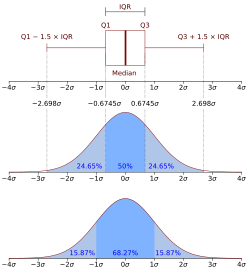In statistics, quartiles are a type of quantiles which divide the number of data points into four parts, or quarters, of more-or-less equal size. The data must be ordered from smallest to largest to compute quartiles; as such, quartiles are a form of order statistic. The three quartiles, resulting in four data divisions, are as follows:
Contents
- Definitions
- Computing methods
- Discrete distributions
- Continuous probability distributions
- Outliers
- Computer software for quartiles
- Excel
- MATLAB
- See also
- References
- External links

- The first quartile (Q1) is defined as the 25th percentile, where the lowest 25% data lies below this point. It is also known as the lower quartile.
- The second quartile (Q2) is the median of a data set; thus 50% of the data lies below this point.
- The third quartile (Q3) is the 75th percentile, where the lowest 75% data lies below this point. It is also known as the upper quartile. [2]
Along with the minimum and maximum of the data (which are also quartiles), the three quartiles described above provide a five-number summary of the data. This summary is important in statistics because it provides information about both the center and the spread of the data. Knowing the lower and upper quartile provides information on how big the spread is and if the dataset is skewed toward one side. Since quartiles divide the number of data points evenly, the range is generally not the same between adjacent quartiles (i.e. usually (Q3 - Q2) ≠ (Q2 - Q1)). Interquartile range (IQR) is defined as the difference between the 75th and 25th percentiles or Q3 - Q1. While the maximum and minimum also show the spread of the data, the upper and lower quartiles can provide more detailed information on the location of specific data points, the presence of outliers in the data, and the difference in spread between the middle 50% of the data and the outer data points. [3]



































